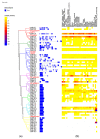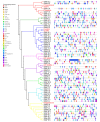Genome-Wide Analyses of Aspartic Proteases on Potato Genome (Solanum tuberosum): Generating New Tools to Improve the Resistance of Plants to Abiotic Stress
- PMID: 35214878
- PMCID: PMC8875628
- DOI: 10.3390/plants11040544
Genome-Wide Analyses of Aspartic Proteases on Potato Genome (Solanum tuberosum): Generating New Tools to Improve the Resistance of Plants to Abiotic Stress
Abstract
Aspartic proteases are proteolytic enzymes widely distributed in living organisms and viruses. Although they have been extensively studied in many plant species, they are poorly described in potatoes. The present study aimed to identify and characterize S. tuberosum aspartic proteases. Gene structure, chromosome and protein domain organization, phylogeny, and subcellular predicted localization were analyzed and integrated with RNAseq data from different tissues, organs, and conditions focused on abiotic stress. Sixty-two aspartic protease genes were retrieved from the potato genome, distributed in 12 chromosomes. A high number of intronless genes and segmental and tandem duplications were detected. Phylogenetic analysis revealed eight StAP groups, named from StAPI to StAPVIII, that were differentiated into typical (StAPI), nucellin-like (StAPIIIa), and atypical aspartic proteases (StAPII, StAPIIIb to StAPVIII). RNAseq data analyses showed that gene expression was consistent with the presence of cis-acting regulatory elements on StAP promoter regions related to water deficit. The study presents the first identification and characterization of 62 aspartic protease genes and proteins on the potato genome and provides the baseline material for functional gene determinations and potato breeding programs, including gene editing mediated by CRISPR.
Keywords: CIS-elements; MEME; abiotic stress; aspartic proteases; intronless; phylogeny.
Conflict of interest statement
The authors declare no conflict of interest.
Figures





Similar articles
-
Genome-wide identification and expression analysis of the StSWEET family genes in potato (Solanum tuberosum L.).Genes Genomics. 2020 Feb;42(2):135-153. doi: 10.1007/s13258-019-00890-y. Epub 2019 Nov 28. Genes Genomics. 2020. PMID: 31782074
-
Genome-wide analysis of the potato Hsp20 gene family: identification, genomic organization and expression profiles in response to heat stress.BMC Genomics. 2018 Jan 18;19(1):61. doi: 10.1186/s12864-018-4443-1. BMC Genomics. 2018. PMID: 29347912 Free PMC article.
-
Atypical and nucellin-like aspartic proteases: emerging players in plant developmental processes and stress responses.J Exp Bot. 2019 Apr 12;70(7):2059-2076. doi: 10.1093/jxb/erz034. J Exp Bot. 2019. PMID: 30715463 Review.
-
Comprehensive genome-wide analysis of Glutathione S-transferase gene family in potato (Solanum tuberosum L.) and their expression profiling in various anatomical tissues and perturbation conditions.Gene. 2018 Jan 10;639:149-162. doi: 10.1016/j.gene.2017.10.007. Epub 2017 Oct 6. Gene. 2018. PMID: 28988961
-
Prospects for potato genome editing to engineer resistance against viruses and cold-induced sweetening.GM Crops Food. 2020 Oct 1;11(4):185-205. doi: 10.1080/21645698.2019.1631115. Epub 2019 Jul 6. GM Crops Food. 2020. PMID: 31280681 Free PMC article. Review.
Cited by
-
A comprehensive and conceptual overview of omics-based approaches for enhancing the resilience of vegetable crops against abiotic stresses.Planta. 2023 Mar 13;257(4):80. doi: 10.1007/s00425-023-04111-5. Planta. 2023. PMID: 36913037 Review.
-
Sugar and Free Amino Acid Contents in Winter Wheat Flour Under Fusarium Head Blight Treatment and Natural Infection.Plants (Basel). 2025 May 16;14(10):1504. doi: 10.3390/plants14101504. Plants (Basel). 2025. PMID: 40431069 Free PMC article.
-
Phylogenetic and AlphaFold predicted structure analyses provide insights for A1 aspartic protease family classification in Arabidopsis.Front Plant Sci. 2023 Feb 3;14:1072168. doi: 10.3389/fpls.2023.1072168. eCollection 2023. Front Plant Sci. 2023. PMID: 36818878 Free PMC article.
-
Genome-wide identification and expression patterns of the aspartic protease gene family in Epimedium pubescens.BMC Genomics. 2025 May 2;26(1):436. doi: 10.1186/s12864-025-11617-7. BMC Genomics. 2025. PMID: 40316908 Free PMC article.
-
Analysis of Genome Structure and Its Variations in Potato Cultivars Grown in Russia.Int J Mol Sci. 2023 Mar 16;24(6):5713. doi: 10.3390/ijms24065713. Int J Mol Sci. 2023. PMID: 36982787 Free PMC article.
References
-
- Rawlings N.D., Barrett A. Introduction: Peptidases of Unknown Catalytic Type. Handb. Proteolytic Enzym. 2013;3:3747–3749.
Grants and funding
LinkOut - more resources
Full Text Sources

